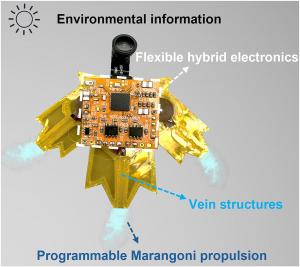Smart aquabots bring camouflage and environmental sensing to life
GA, UNITED STATES, October 21, 2025 /EINPresswire.com/ -- Small-scale robots designed to operate on water surfaces face challenges in mobility, adaptability, and multifunctionality. This study introduces bio-inspired "S-aquabots" powered by a programmable Marangoni motor (PM-motor), enabling highly controllable propulsion, efficient fuel use, and silent motion. The robots mimic natural leaves, blending seamlessly into aquatic environments while achieving a 3.5-fold improvement in fuel efficiency compared to conventional designs. With flexible hybrid electronics, the S-aquabots perform complex maneuvers, transmit real-time video, and monitor environmental conditions. By combining biomimicry with advanced engineering, these devices open new possibilities for environmental monitoring, pollution control, and adaptive robotics in outdoor aquatic systems.
Aquatic robotics holds great promise for environmental monitoring, search and rescue, and pollutant removal. Yet, small water-surface robots often struggle with limited power, bulky functional units, and a lack of precise control. Conventional actuation approaches using piezoelectricity, magnetism, or shape-memory alloys have yielded only partial success, as many designs require tethered power or sacrifice adaptability. Nature offers better solutions: beetles, for example, release low-surface-tension liquids to move rapidly across water. This principle, known as the Marangoni effect, inspired researchers to explore fuel-efficient propulsion for artificial devices. Based on these challenges, there is a pressing need to develop untethered aquabots with precise maneuverability, adaptability, and integrated sensing.
Researchers from the University of Macau and Huazhong University of Science and Technology have developed programmable, leaf-inspired "S-aquabots" powered by a Marangoni motor. The study was published online in eScience on May, 2025. Using ethanol-fueled propulsion, flexible hybrid electronics, and biomimetic design, the centimeter-scale robots achieve silent, energy-efficient mobility and environmental adaptability. Demonstrations included obstacle avoidance, pollutant collection, and real-time video transmission, showcasing their potential for long-term outdoor monitoring and future applications in environmental and aquatic robotics.
The programmable Marangoni motor (PM-motor) is the key innovation driving these S-aquabots. Ethanol stored in chambers is precisely released through vein-like channels under electromagnetic control, generating surface tension gradients that propel the robot forward. This design improves fuel efficiency by 3.5 times, with just 1.2 mL of ethanol enabling navigation for 226 seconds over distances of ~5 meters. The robots perform U-turns, rotations, and predesigned trajectories—including a butterfly-shaped path guided by laser spots—showcasing programmable control. Their leaf-inspired shapes allow camouflage among floating vegetation, while motion remains nearly silent (~40 dB, comparable to natural background noise). Depending on shape, the aquabots balance speed, stability, and camouflage functions, offering specialized roles. Integration with mini-cameras or digital sensors enables real-time video transmission and long-term environmental monitoring, such as recording light intensity and air temperature over extended periods. The compact flexible electronics also support wireless control, autonomous responsiveness, and rapid communication within 50 meters. Together, these features highlight a novel strategy for designing adaptive, untethered water-surface robots with both engineering efficiency and ecological stealth.
"Our leaf-inspired S-aquabots demonstrate how biomimicry and advanced materials can overcome the long-standing challenges of aquatic robotics," said corresponding author Prof. Junwen Zhong. "By combining programmable Marangoni propulsion with flexible electronics, we achieved both precise control and multifunctionality in untethered water robots. Importantly, the quiet motion and natural camouflage open possibilities for unobtrusive environmental monitoring. We believe this approach represents not only a technological breakthrough but also a blueprint for future designs of intelligent, adaptable, and eco-integrated robotic systems operating in diverse aquatic environments."
The newly developed S-aquabots present broad applications in environmental science and robotics. Their silent motion and camouflage make them ideal for ecological monitoring without disturbing wildlife. Equipped with cameras or sensors, they can track pollutants, monitor water quality, or gather weather-related data over long periods. Their precise maneuverability allows use in search-and-rescue scenarios, where small robots can inspect hazardous or hard-to-reach water surfaces. Looking forward, integrating sustainable energy sources such as solar cells could extend their endurance. This work represents a critical step toward versatile, adaptive, and eco-friendly aquatic robots capable of supporting environmental protection, scientific research, and disaster response.
References
DOI
10.1016/j.esci.2024.100335
Original Source URL
https://doi.org/10.1016/j.esci.2024.100335
Funding information
This work is supported by the Science and Technology Development Fund of Macau SAR (File No. 0117/2024/AMJ), the National Natural Science Foundation of China (No. 51925503, 52188102), the University of Macau (MYRG-GRG2023-00041-FST-UMDF, MYRG-GRG2024-00121-FST, MYRG-CRG2024-00014-FST-ICI), the Xplorer Prize (2020-1036), and the Comprehensive Experiment Center for Advanced Manufacturing and Equipment Technology, HUST, Wuhan, China.
Lucy Wang
BioDesign Research
email us here
Legal Disclaimer:
EIN Presswire provides this news content "as is" without warranty of any kind. We do not accept any responsibility or liability for the accuracy, content, images, videos, licenses, completeness, legality, or reliability of the information contained in this article. If you have any complaints or copyright issues related to this article, kindly contact the author above.

